Samuel Lewis in his Topographical
Dictionary of Ireland published in 1837 describes Kilfane as a parish in
the barony of Gowran, 2
miles north of Thomastown with 898 inhabitants at that time and with
90 children in the parochial school. It comprised 3830 statute acres.
The Church of Ireland of Kilfane included the
vicarages of Tullaherin and Blanchevillestown and in the Roman Catholic division it
formed part of the union of Thomastown. The 1851 Alphabetical Index of
Townlands which was based on the census described Kilfane as having two
sections, the Demesne East and West and within the Barony of Gowran and
the Poor Law Union of
Thomastown.
The Shell Guide to Ireland 1962 ( by Lord Killanin and Michael V. Duignan) states that Kilfane was the site of an early monastery and consisted of the ruins of a 14th century medieval church which served as the church of Ireland or Protestant church until 1850. The inside of the ruins are very interesting and if you look carefully you can still see faint traces of painted medieval red crosses inside circles; these are near the doorways. The tower on the north side was the priest's residence. This graveyard contains both Catholic and Protestant burials.
Kilfane gets its name from St Paan, Kilfane meaning the
church of St Paan.
Paan was the son of Bracan, a Welsh prince and
Dina, the daughter of a Saxon king. They also had several other saints
amongst their offspring which included Melaria, the mother of St David
of Wales.

The graveyards site is not so large but is in several sections. Our survey and recording at Kilfane begins with Section One which is within the ruined church. We then moved to Section Two which contains the six Seigne family memorials on the right
side of the laneway and outside the enclosed graveyard. Next we recorded the Lower Graveyard which we called Section Three; in this section you can find the entrance to the Power Family Mausoleum which has been severely disturbed over the centuries. It is now locked shut. We then returned to the enclosed graveyard which we divided into Section Four and Five. Section Four, which contains the Catholic burials, is on the south side of the ruined church; these memorials continue all the way to the end wall of the graveyard. Section Five lies across and behind the
church on the east side. This is where the Church of Ireland internments begin and this section continues around the church on its north side back to the entrance laneway. We
have created a detailed map of this graveyard as not all the early stones are easily read or located.
Section 4 which contains mainly Catholic burials shows evidence of a vibrant and affluent Catholic community who had the funds to erect family memorials and headstones. Altogether in this Section alone there are 22 memorials dating from the 18th Century. These are:- 1720, 1737, 1742, 1744, 1751, 1761, 1762, 1763, 1765(x2), 1770, 1772(x2), 1773, 1775, 1781, 1788(x2), 1789, 1790, 1794 and 1798. Additionally there are 19 headstones dating from the period 1800-1850. These are:- 1802(x2), 1807, 1809, 1811, 1815, 1818, 1820, 1822, 1827(x2), 1829(x2), 1828, 1830, 1832, 1833, 1837, 1840.
Section One: Inside the ruined church
1. Here lyeth ye body of Margaret Motley alis Jones who died Mar ye 3rd 1735. The many Motley graves mentioned in 1974 Old Kilkenny Review at Kilfane are not evident there now.
Very
Rev. James Mottley was the Catholic P.P. Kilmacow and Mullinavat in 1748, he died
about 1756. He was a native of Kilfane. His father was John Mottley and
his maternal uncle was an unnamed Protestant Clergyman. (
See Carrigan in The History and Antiquities of the Diocese of Ossory) p144 Vol.1V).
At St John the Evangelist in Kilkenny city there is another Mottley memorial which is no doubt a relation of Margaret Motley buried in Kilfane church. (
Here lieth the body of the Reverend Father Walter Motley parish priest of St Johns, He died september ye 27th 1750, aged 79 years. Requiescat in pace. Amen).
2. Broken stone with two coats of arms on a shield - Martin Impailing Hartstronge.
Here lyeth the body of Mrs Eliza Follitt desceased wife of the Reverend Mr Thomas Martin, prebendary Kilmanagh and 2nd daughter of Sir Standish Hartstronge Bart, Baron of the Court of Excheqr in Ireland in ye reign of King Charles ye 2nd who departed this life ye 27th and was interred ye 10th day of October 1720 in ye 66 year of her age.
The Latin part of this inscription translated in Memorials of the Dead (Vol)?..
" I have made this grave in loving memory of wife who for 34 years enjoyed a close married bond in the same grave dust ashes united until the reunion altogether at the general ressurection. Husband, sons and daughters confident of his care"
The Rev Thomas Martin is probably identified with Thomas Martin, son of Thomas Martin of Limerick who entered TCD in 1677 and who obtained a BA 1684. He was made Prebendery of Kilmanagh 1710 by his brother-in-law, Dr John Hartstronge, Bishop of Ossory. His will was proved in August 1730 and he left a son and two daughters - the Rev Hartstronge Martin married Sarah Weyms of Danesfort. The two daughters of Rev Thomas and Elizabeth Hartstronge were - Mary who married Arthur Bushe of Kilfane and Martha who married William Waring of Pottlerath, county Kilkenny. Sir Standish Hartstronge was for several years Recorder of Limerick before being made a Baron of the Exchechquer.
3.
Here lyeth depositied in the hope of the resurrection to everlasting life Richard Lee late of Clonderla in the county of Clare Esqr., the son of Henry Lee Esqr., descended from the ancient family of Darnold Hall in Cheshire. He dyed of small pox ye 12 day of March 1707 leaving only one son of 3 years old.
Rarely is justice done to the Just
In his case of necessity it must
Cause you'll speak well or you must silent be
He was composed of love and charity
A bright example to posterity
Reader if in his paths you rightly tread
Doubt not of being happy when you'r dead
Life here below he did but little prize
E'r having life above before his eyes
Ever remembering that the soul ne'r dyes
The initial letter of the first word of every line spells out
Richard Lee. This is called an
acrostic poem.
Henry Lee of Castle Craig, Tipperary was supposedly the grandson of Cromwell Lee KG and who settled in Ireland; he purchased in 1678 the lands of Barna or Rossacully, barony of Owney and Arra, county Tipperary. In the same year a Henry Lee Esq., had a grant under the Act of settlement of Moyfadda in the Barony of Clonderlaw, county Clare. It is unclear if these two Henry Lee are the same person or not. Henry Lee Esq., had a son Richard of Clonderlaw, county Clare born in 1665 (will dated 8th May 1707 and proved 19th July 1707) who married Agnes sister of Henry and George Rose. Richard's son mentioned on the above stone is thought to be Thomas Lee (born 1704) who married his cousin Susan Vandeleur of Kilrush (Her Lee descendent is via Elizabeth Crofton Esq., of Inchirourke, county Limerick; Elizabeth Crofton married Rev John Vandeleur of Cragg, county Clare, Rector of Kilrush.
Two other headstones now lying flat within the church and close to each other
4. Erected by James Hendricken of Kilfane in memory of his daughter Elizabeth Hendricken who departed this life on the 1st January 1835 aged 22. Requiescat in Pace. Amen
Mason: William Beck
5. 2nd stone lying flat; Dcorated with a lancet window.
Erected by John Lanigan of Kilfane in memory of his beloved wife Mary Lanigan alias Hendricken depd this life Septr 19th 1853 aged 62. Also her father James Hendricken who departed this life Augst 15th 1840 aged 93 years. Also her mother Abigal Hendricken who depd this life August 10th 1844 aged 76 years. Requiescant in Pace Amen.
Mason: Thomas Beck.
6. Standing also inside the ruined church is a magnificent limestone effigy dated to circa 1320 of
An Cantwell Fada meaning in English The Long Cantwell. This is a cross legged effigy of a knight in full armour with the Cantwell arms on his shield and by tradition was the tomb and effigy of the ancient Lord of Kilfane and other lands in county Kilkenny.
7. A pile of broken memorial stones piled up and lying below the east window and to the left of the altar. This is now all illegible but appears in
The Clergy of Ossory as
"Here lyeth the body of Revd M. Hartstonge Marten (sic) formerly Minister of the Union of Kilmanagh who departed this life on ye 27th Dec 1728 in the 37th year of his age".
8. Not found by us but recorded in the
Preservation of the Memorials of the Dead (submitted to that Journal by Mr John Hewetson) but now most probably broken up and beneath the pile of stones under the east window mentioned in No 7 above.
"Here lieth the body of Nicholas Marten A.M.(sic) late Prebendary of Blackrath...….He departed this life on the 13th day of January 1779 aged 75 years. Abi et imitare" (translates as Go and imitate). Nicholas Martin was the son of Thomas Martin and born in county Cork. He entered TCD in April 1722 aged 17, obtained a BA in 1727 and an MA in 1731. He was Prebendary of Blackrath (anciently called Madokestown) in the Cathedral Church of St Canice from 1772 until his death. The Ossory Will of Nicholas Martin of Irishtown, Kilkenny was proved in 1779. For further information about his career
see The Clergy of Ossory.
Below is a picture of the sedilia in the ruined church. This is to the right of the altar. Set into the south wall and used as seating for priests during services.
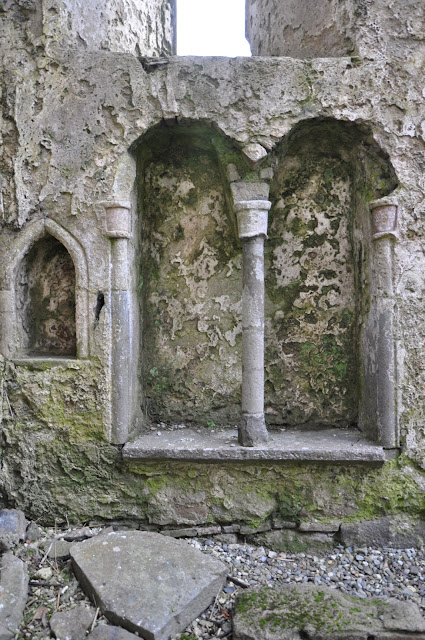
The image below depicts a Hagioscope or a Squint
situated in the north east corner left of the altar. A Squint is described as a narrow opening in an interior wall
of a church allowing a view of the altar from the other side. Ceremonies could be seen
and heard, and in this case from the ground floor of the Presbytery, so that infirm members of the community could view the altar and the Celebrant but were not visible to the congregation.
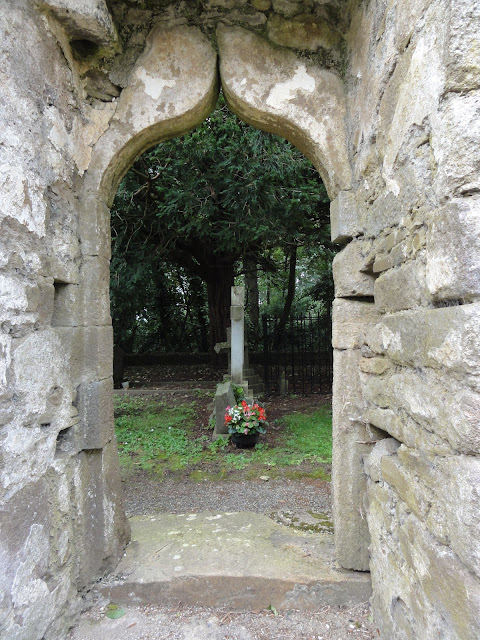 |
| Ogee headed doorway North facing |
Section Two. The Seigne Family Plot
This
consists of six memorials, five of which are lying flat and in a single
line and enclosed behind iron railings on the right of the laneway,
outside the walled graveyard to the south of the ruined church. Each
stone is decorated on the top with a carved chalice or urn
9. In memory of Joseph Seigne who died 2 June 1901 aged 91 years. Also in memory of Susan Seigne his wife who died 12th March 1892 aged 75 years. blessed are the dead which die in the Lord.
10. This monument is erected by Anthony Seigne of Dangan in memory of his beloved daughter Anne Minchin alias Seigne who depd this life on the 5th day of Augt in the year of Our Lord 185? aged 26 years. Also of her daughter Harriet Minchin that died young.
11. This monument was ereted by Anthy Seigne of Dangan in memory of his mother Anne Seigne alias Goff of Kilfane who depd this life the 16th of Novr 1805 aged 75 years. Also his father Joseph Seigne of Kilfane who depd this life the 16th Augt 1810 aged 51 years. Also his daughter Mary Seigne who depd this life 17th of Jany 1820 aged 26 years.
12. Erected by Thos Seigne in memory of his beloved father Mark Seigne who died Decmbr 11th 1827 aged 60 Years. Here lies the remains of him who was loved as life by sons and daughters and tender wife. Also his beloved sister Rebecca Seigne who departed this life March 11th 1828 aged 29 years.
13. In memory of Thomas Seigne of Kilfane Cottage who died Febry 20th 1871 aged 71 years.
He was beloved by many friends and earned a widespread respect as agent over the estate of Sir John Power of Kilfane during a period of nearly 50 years. Also in memory of Maria Seigne his wife who died Novr 17th 1875 aged 77 years. Blessed are the dead which die in the Lord.
14. Upright slab inserted against the back wall. This burial ground belongs to Joseph Seigne and this plate erected in memory of his beloved son Thomas Seigne who departed Novr 3rd 1795 aged 24.
Years.
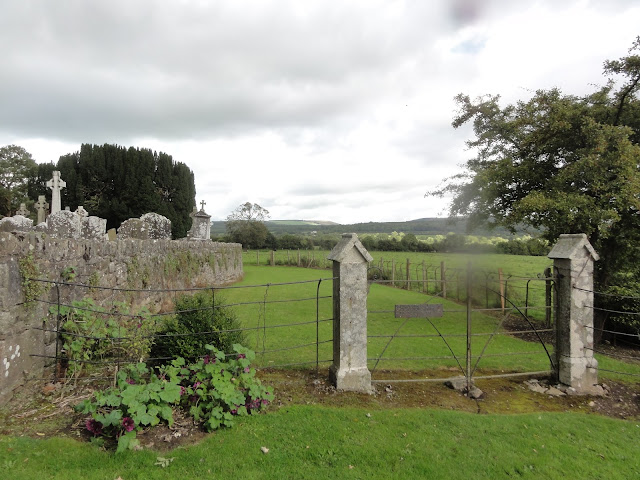 |
| Entrance gate to lower graveyard |
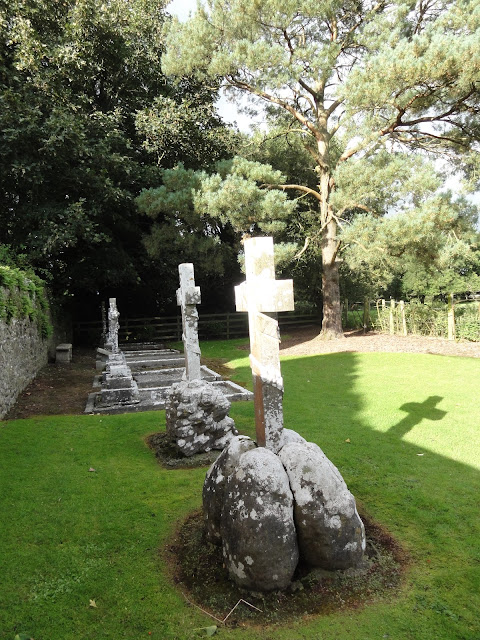 |
| The Power Memorials in the lower graveyard |
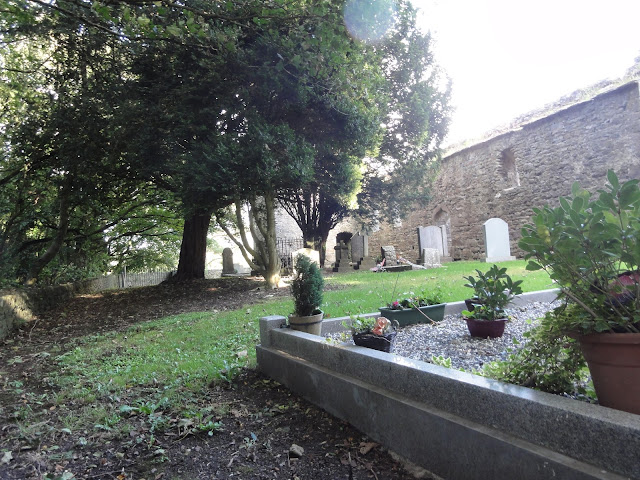 |
| A view Looking east on north side of the ruined church |
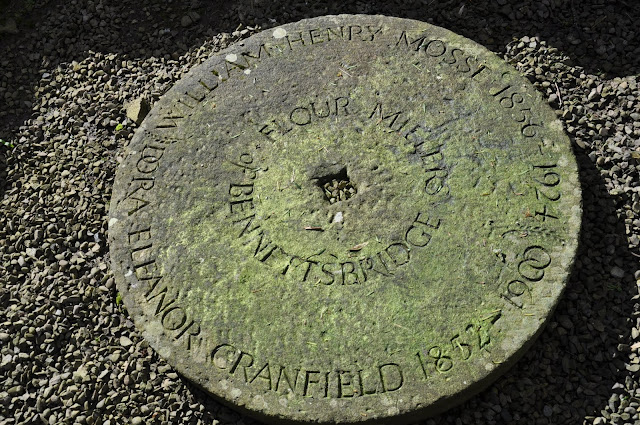 |
| The Mosse Family Memorial, a Millstone commemorating William Henry Mosse and his Wife Dora Eleanor Cranfield |
List of names of the memorials
Bolger 110,
Bookle 55,
Boyle 47,
Brandon 114,
Bushe 111,
Butler 46, 88,
Byrne 99,100,
Cannon 88,
Cantwell 6,
Casey 15,
Chamberlain 115,
Cody 40
Cooke 39
Cranfield 120
Croke 15
Cummins 92
Cunningham 107
Darcy 75
Dempsey 22
Dixon 140
Dowling 73, 74
Dudley 128
Dunne 35
Edwards 75
Farrell 60
Flood 47
Flynn 60, 78
Foley 40
Follitt 2
Forde 103
Galway 82
Goff 147
Graham 147
Gready 41
Greenslade 112
Hara 55, 56
Hartstronge 2, 7
Halford 42
Heffernan 102
Henriken 4
Hendricken 5
Hickey 43
Holland 84
Irwin 115
Jones 1
Kealiner 66
Keefe 54
Kelly 34
Kearney 63,64
Laihain 28
Lanigan 107,108
Lee 3, 25
Maher 61
Marten 7,8, 57
McDonald 49
Meaney 83,84
Mercer 129, 131
Menchin 10
Miller 146
Moressey 86
Mosse 120
Motley 1
Murphy 44,55,61,71,93,104,108,147
Normoyle 128
Nowlan 43,44,45, 50, 51, 65, 66, 79
Pa;mer 147, 148
Pendergt 63
Power 13, 16, 17, 18, 19, 20,21, 23, 24, 25
Purcell 27
O`Brien 91
O`Hara 55,56
O`Keeffe 94,102,113
Rice 35,51, 52
Riley 49
Robinson 127
Rothwell 146
Ryan 98,101
Seigne 10, 11, 12, 13, 14, 37
Shee52
Shehy 41
Shortill 83
Summers 87
Veasy
Walpole 76
Walsh 56, 82, 93, 101
Watts 117
Whitelock 118
Williams 116, 130, 131,132, 133, 134, 135, 138, 139, 141, 142
Younge 119
List of places recorded on the memorials
Archer St 60
Bennetsbridge 120
Blackrath 8
Blackwell Lodge 119
Caran 35
Carhan 46
Clanderla 3
Clare 3
Chesshire 3
Clossgregg 110
Cloughscregg 34, 71, 78
Cloughscregg 22
Coum 49
Dangan 10, 11
Darnold Hall 3
Dunbell 52
Dungarvan 53, 100, 132, 138
Gowran 43
Huntingtown 53
Kilbline Stud 116
Kilfane 4, 5, 11, 13, 17, 18, 19, 21, 24, 28, 83, 84, 108
kilfane Church 25, 147
Kilfane Cottage 13
Kilinshawn 45
Kilkenny 40, 60
Kilkenny, county 119, 130
Kilmanagh 2, 7
Kilmurry House 15, 114
Kilmanagh 2,7
Lindley 19
Maddoxtown 64
Nore 23
Old Racecourse 58
Oldtown 119
Ossory 115
Queens county 119
Ruppa 86
St Canices Cathedral 24
Sligo 115
Smithstown 37, 94, 113
South Africa 18, 19
Stoneen 76, 101
Sugarstown 102, 103, 104
Summerhill 147
Tanragoe 115
Thomastown 22, 59, 75, 110, 107
Thostown 93
Tullaherin 101
Tullow Cottage 130. 131, 132, 133, 138
Tullow Lodge 141
Walkin Street 27
List of Occupations recorded on the memorials
Agent 13
A.M. 8
Archdeacon 115
Barron 2
Baronet 18, 19, 20, 21
Bart 17
Boys Brigade Captain 112
Canon 24
Captain 18, 115
C aretaker 25
Colonel 115
Curate 24
DSO 24
Flower Miller 120
Judge 115
Linen Draper 40
Lt. Col 147
Rector 24
Reverend 2, 7, 23
School Teacher 112
Venerable 115
List of masons and blacksmiths who have signed memorials
Thos Beck, Thomastown 5
William Beck, Thomastown 4
R Collis, Kilkenny 119
Downes, Kilkenny 115 (signed railings)
Molloy, Callan 116
Mullen, Kilkenny 76
O`Keeffe and sons, Waterford
O`Shea Callan and Kilkenny 115 (stone xv)




